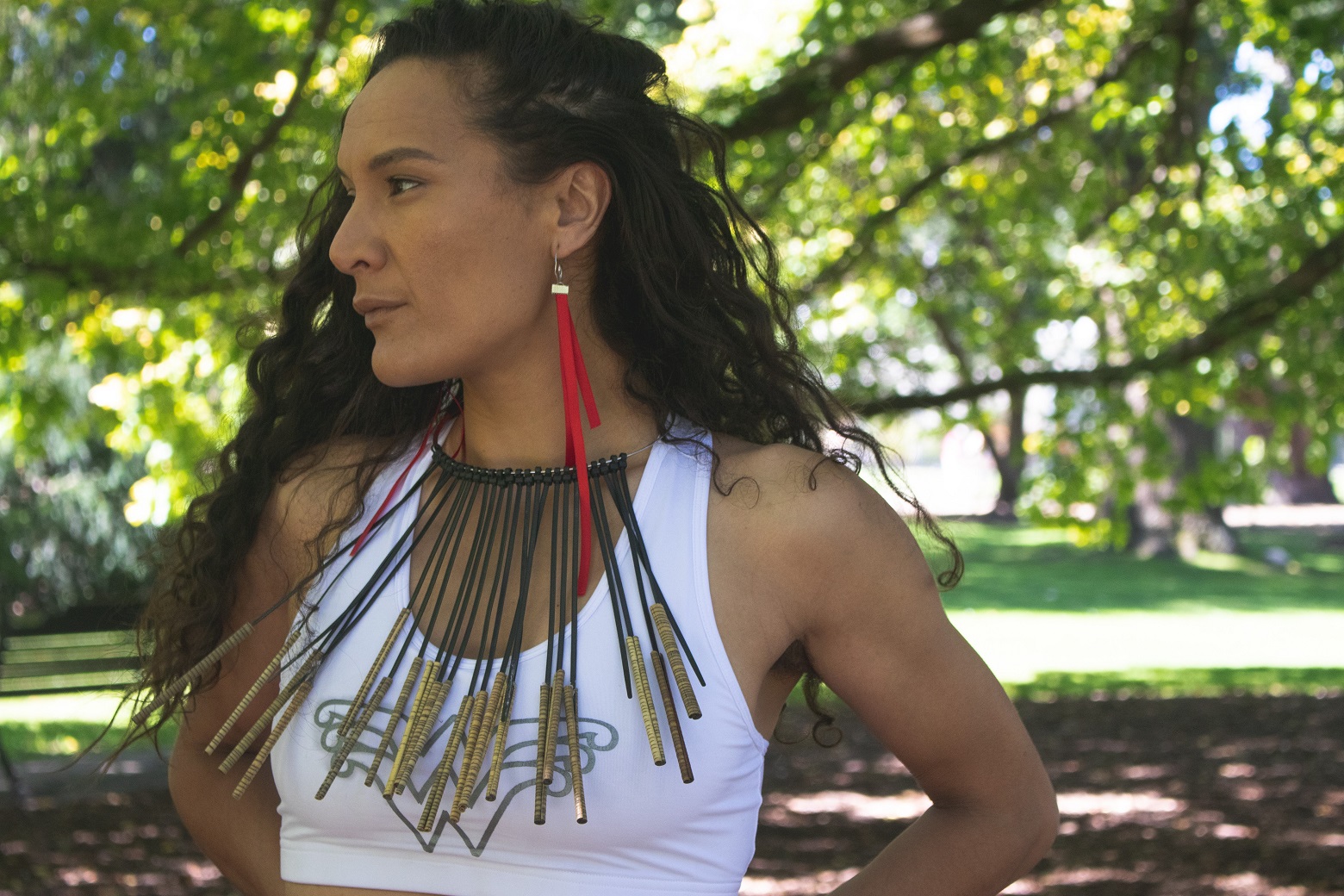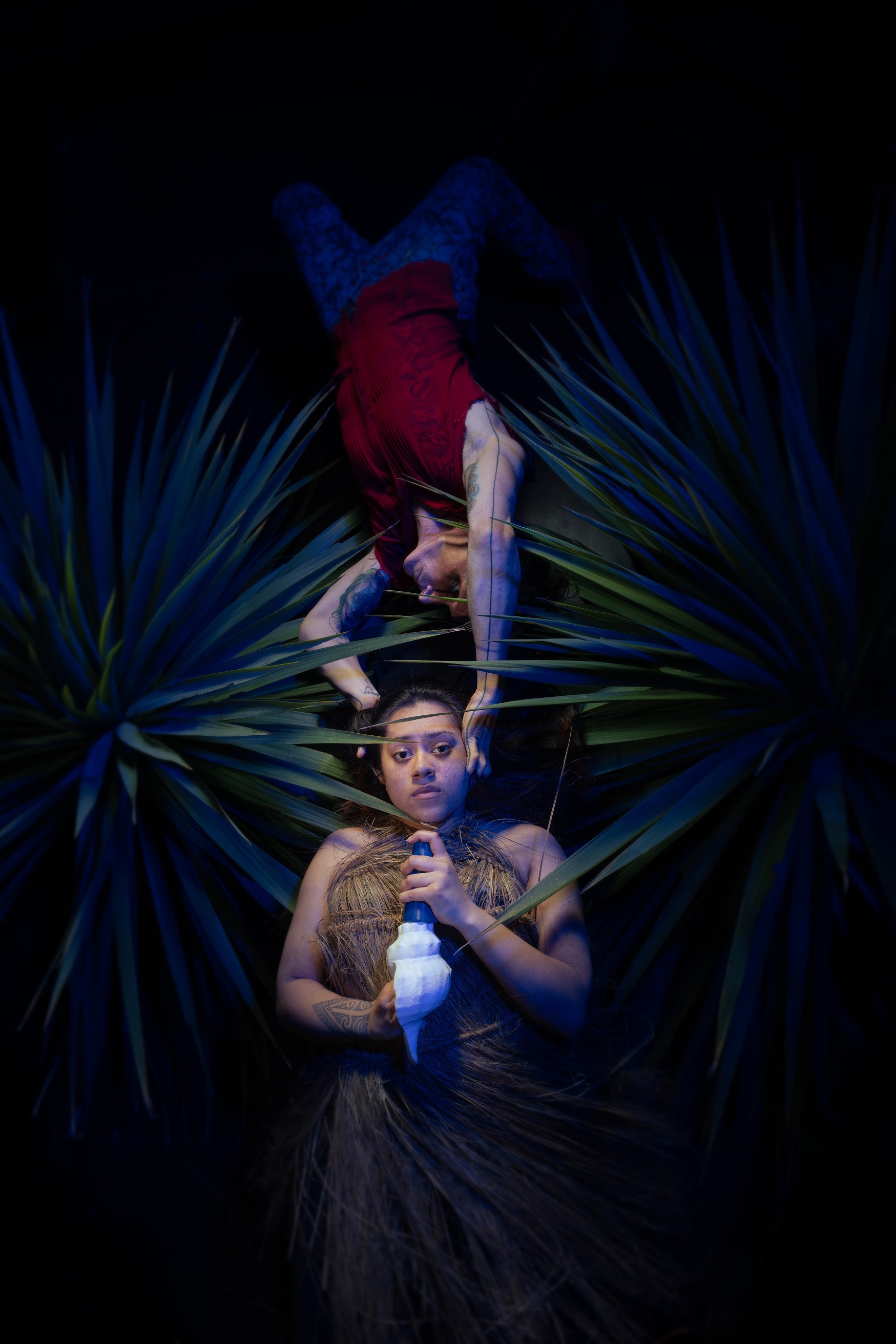
A pandemic has ravaged the world, a war has ended and economic uncertainty is taking hold.
It was 1918 and Igor Stravinsky wrote The Soldier’s Tale, considered to be his greatest work for narrator and orchestra.
More than a century later, writer and director Juanita Hepi (Kāi Tahu, Waitaha, Kāti Māmoe, Ngāti Mutunga, Moriori, Ngāti Kahungunu, Ngāti Wai, Ngāpuhi) looks at the work and sees the parallels to today’s world.
"I was really excited about how this particular one, The Soldier’s Tale, mirrors what is happening [around the] globe today, even though it was written so long ago."
The work was brought to Hepi’s attention by Chamber Music New Zealand (CMNZ) who were keen for her to devise a piece for them using her multi-disciplinary skills based on the Stravinsky work.
CMNZ had seen what Hepi had done in 2021 with the Christchurch Symphony Orchestra in Tūmahana, based on the Ngāi Tahu story of creation as written by Matiaha Tiramorehu in 1849, which wove together elements of dance, aerial and visual arts, Toi Māori, Taonga Pūoro, and orchestral music by Stravinsky.
"We completely changed the narrative and music — you almost wouldn’t be able to tell it was Stravinsky."
Hepi could not turn them down, jumping at the opportunity to showcase the talents of Ōtautahi, Christchurch and Te Waiponamu, the South Island.
"Sometimes I feel like we get left behind a little bit in the arts world, yet we have amazing artists and amazing arts.
"It is a Faustian tale, that tale is a global narrative that everybody can relate to. I like works that appeal at a global level that you can adapt to a macro-regional level."
So the team from Tūmahana — Hepi, composer and performer Hamish Oliver and Cirko Kali’s Danny Lee Syme — reunited and began work on what has become Hine Hōia.
Hepi, who has a masters of Māori and indigenous leadership, a graduate diploma of teaching and learning and a bachelor of arts from Toi Whakaari, the NZ Drama School, started by researching Stravinsky’s life and times, as well as the narrative behind The Soldier’s Tale, finding it had been written at the end of a pandemic and war and as the world was going through socio-economic strife.
"It really inspired the narrative I was pulling out myself. Obviously we have been through Covid, there is this potential of war that has kind of come in to our psyche more.
"We are getting scared about arms and countries at war and on top of that worried about economic future, especially now with prices going up. It’s a concern that is happening around world."
She wanted to play on that idea and the concept of what people struggling will do to survive.
"What are you willing to give up to have the things you want? And what is truly worth having? What would you do to be happy again?"
Given it was a New Zealand production, she wanted to make the story reflective of the country’s own identity and struggles, but also to mirror what was happening globally.
So instead of a soldier, Hine Hōia, a young Māori wahine, takes the lead, as Hepi draws on her own family history for inspiration. Her grandmother and her sisters were sent to an orphanage on the North Island’s East Coast as teenagers.
"So it’s not a soldier running away from war; there were other kinds of areas where teenagers were taken or left their families. That is how I came up with Hine Hōia. She is running from the orphanage to try and get home, which I’m sure a lot of children back in the 1900s would have at least felt."
And instead of World War 1, it is the New Zealand wars that have come to an end; yet as with the rest of the world the Spanish flu pandemic has also ripped through the country, leaving Hine Hōia standing on a precipice until a chance encounter changes her life.
Hepi wanted the character to be vulnerable but brave in the face of the hard decisions she has to make.
"She has to be strong enough that we believe the decisions she is making. Most of us when we make those decisions, we are thinking really hard about them and we’re really thinking about the outcomes of those things. Sometimes the hardest decision is the best decision, but sometimes it might not look that way from the outside."
For that role the team cast Tōmairangi Paterson-Waaka, recent winner of the Nasda (National Academy of Signing and Dramatic Arts, Christchurch’s performing arts school) emerging practitioner award, and a student of Hepi’s. Hepi is a strong proponent of creating strong roles for students to go into — especially in the South, rather than having to follow the work north.
"It wasn’t necessarily the case when I came out of drama school, but I wanted to change something I struggled with coming out into the industry. As well we also needed somebody who could sing, dance and act and was comfortable getting up in circus rig."
And just like The Soldier’s Tale there is a narrator or Kaiwhakataki, performed by Regan Taylor (Ngāti Kahungunu Te Arawa), a member of the The Māori Sidesteps,
The piece has taken Hepi in a new direction, as her previous work has focused on Ngāi Tahu narratives and artists.
"This time I’m really focusing on us as a country, and trying to make it more of a New Zealand narrative rather than Kāi Tahu specific, and that is partly because it is touring as well. It was important everyone was included in the narrative."
As she was angling the piece towards a younger audience, she enjoyed the opportunity to play with the archetypal bad and good guy characters, creating The Devil, or Te Taipō, played by Syme.

"It’s taken a lot of research and writing — and rewriting — but I have absolutely loved it."
The original score has been written with room for improvisation and is performed by Oliver on keyboard and electronics, Seta Timo on bass, and Jono Blackie on drums and percussion. Mahina-Ina Kingi-Kau is on taonga puoro.
Hepi is full of praise for CMNZ initiating the multi-artform project, which is a first for the chamber music organisation.
"It’s a great move by CMNZ to invest in this type of work — it’s not easy, and has a lot of challenges."
Preparing for a stage show involving so many different art forms — circus, music, theatre, dance — in comparison to just chamber music, as it has done before, was one of them.
Including circus in her work comes naturally to Hepi, who has always been a physical theatre performer and intrigued by the art form. When she first saw circus training she fell in love; it may be a family trait, as her father ran away with the circus as a young man.
"I fell in love with way the artists move their bodies and contort their bodies. I find that quite amazing. I was tempted to join, but I chose to go the acting route."
When she first started, artists chose one discipline to follow and stayed with it.
"If I could go back, I would do all of the things — I’d be doing circus classes, violin classes. I think we had this idea back then that you chose one discipline and you stayed within it.
"Now I’m a multidisciplinary artist, producer and director, so I’m trying to pull in all sorts of different ways of storytelling into a narrative."
Her goal is to fully integrate circus into the narrative just like acting and music so "you are almost not sure who is doing what".
"Circus has generally been performed one way. We go to the circus and know what to expect, so I really like to subvert those kinds of ideas.
"It really lends itself to Māori narratives and it really lends itself to epic narratives. It’s a great way to play with space and a new way of looking at circus. I hope. It’s all very aspirational."
Hepi likes nothing better than a challenge and these days goes wherever there is "awesome kaupapa" — as long as it is in the South Island.
She made a "staunch" decision to stay in Christchurch and support the creative industries of Te Waiponamu, rather than travelling to the North Island for work.
Growing up in Christchurch, her generation were lucky to have the Pacific Underground and a lot of artists making work in the city such as Bic Runga, Anika Moa and Scribe — until they all left to follow their careers. There just was not the infrastructure to support them, or a lot of opportunities.
"Because I myself had to leave, I don’t want our artists to have to leave our families and places they love to work. It would be great if they could live and work in the places they want to be."
So she teaches at Nasda and is working on developing a Māori art space, Te Whare Tapere ā Toi, at The Arts Centre Te Matatiki Toi Ora. Recently she has written and directed Matariki Around the World for the Christchurch Symphony Orchestra and worked on the Christchurch City Council’s Matariki light festival, as well as a music video for friends. She also mentors.
"I like to keep very, very busy and support our stories to get told. I did my masters in Māori women in theatre, so I’ll always be drawn to where those narratives might be bubbling up and where those writers are."
To that end, Hepi has been involved in Dunedin writer Jessica Latton’s first play The World's First Lovers. She dramaturged Latton’s draft script years ago and came back to direct it for its premiere in Wellington with the support of Prospect Park Productions.
"It’s a really, really beautiful story itself. It is very dark, it’s about Jessica growing up in Dunedin in the 1980s as a wahine Māori, and the ’80s for anybody was quite a dark time. We were looking at how we could talk about those narratives without making it a dark piece and it ended up being a really beautiful piece."
While Hepi sees her work as a progression of what has been done by people before her, she acknowledges the responsibility she feels to support indigenous storytelling, while also wanting people to be entertained and excited about their work.
"Anybody who knows me knows I cannot stop thinking about a theme. I’m very critical about every word, I try to peel back layers of what we are trying to say."
CMNZ chief executive Rose Campbell said the organisation embraces the role it plays in providing opportunities for new art experiences to be developed, created, and performed.
"It is our pleasure to present the world premiere of Hine Hōia within our 2023 CMNZ Series.
"This multidisciplinary work explores the intersection of race, class, and gender through storytelling and cross-cultural collaborations, and we look forward to sharing it with our audiences."
TO SEE:
Hine Hōia, Chamber Music New Zealand, King’s and Queen’s Performing Arts Centre, August 16, 7.30pm












